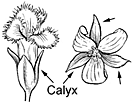`Opiuma
Pithecellobium dulce
Pea family (Fabaceae)
Post-Cook introduction
This tree, introduced about 1870 for shade in dry lowlands, has become naturalized. It is identified by paired sharp spines usually present at base of leaf, twice leaves with 4 oblong small creamy white flowers in balls of 3⁄8 inch (1 ), and curved or coiled pink to brown pods with several shiny black seeds mostly covered by whitish pulp. Mimosa subfamily (Mimosoideae).

W. John Hayden
Leaves with pair of slender, sharp spines () 1⁄16–5⁄8 inch (1.5–15 ) long usually present at base, very slender green leafstalk of 1⁄4–1 1⁄2 inches (6–38 ) with tiny round near and 2 lateral axes () only 1⁄8–1⁄4 inch (3–6 ) long. four in pairs, nearly stalkless, oblong or 1⁄2–2 inches (13–50 ) long and 3⁄16–5⁄8 inch (5–15 ) wide, rounded at the oblique base rounded or short-pointed, not on edges, thin or slightly thickened, hairy or hairless, dull pale green above, and light green beneath.
Flower clusters (heads) many, short-stalked in slender drooping or lateral axes, each covered with whitish hairs and composed of 20–30 densely hairy flowers. Each flower has tubular hairy five- about 1⁄16 inch (1.5 ) long; funnel-shaped tubular hairy five- about 1⁄8 inch (3 ) long; about 50 spreading long threadlike united into short tube at base; and with hairy and threadlike
Pods 4–5 inches (10–13 ) long, 3⁄8–5⁄8 inch (1–1.5 ) wide, slightly flattened, inconspicuously hairy. Seeds are beanlike, elliptical, 3⁄8 inch (1 ) long, hanging down from open pod, inside pulpy edible mass (aril) as much as 3⁄4 inch (2 ) long. With flowers in spring and from April to June.
Sapwood is yellowish, and heartwood yellowish or reddish brown. Wood is moderately hard, heavy, strong, and durable. It takes a high polish but is brittle and not easily worked.
Elsewhere, the wood is employed for general construction, boxes and crates, posts, and fuel. The bark has been harvested for its high tannin content. It also yields a yellow dye and is an ingredient in home remedies. A mucilage can be made by dissolving in water the transparent deep reddish brown gum that exudes from the trunk.
The thick whitish sweetish acid pulp around the seeds can be eaten or made into a drink. Livestock browse the pods under the trees. The flat black seeds are strung into leis in Hawaii. The tree is also a honey plant. This attractive species makes a good highway and street tree, especially in dry areas, growing rapidly and enduring drought, heat, and shade. It withstands close browsing and pruning and is suitable for fences and hedges. Formerly, it was a popular street tree in southern Florida. However, it was susceptible to hurricane damage and did not recover well.
In Hawaii, this species is planted and naturalized in pastures and waste places through the dry lowlands. It is of frequent occurrence along the highway near Haleiwa, Oahu, and in the scrub forest near Lahaina, Maui. One cultivated form has variegated green and white leaves. Degener (1930) reported that the false mynah bird eats the fleshy seed covering and spreads the seeds. According to Neal (1965), the Hawaiian name ‘opiuma is from the resemblance of the seeds to the opium of commerce.
Champion
Height 66 ft (20.1 ), c.b.h. 24.9 ft (7.6 ), spread 107 ft (32.6 ) Napoopoo, Hawaii (1968).
Range
Mexico (Baja California, Sonora, and Chihuahua southward) through Central America to Colombia and Venezuela. Widely planted and naturalized in New and Old World tropics. Introduced in southern Florida and Puerto Rico and Virgin Islands.
Other common names
gaumuchil, Manilatamarind, Madras-thorn; guama americano (Puerto Rico); guamuche (Mexico, commerce); kamachili (Guam, N. Marianas); kamatsiri (Palau)
This species was named and described botanically in 1795 from Coromandel, India, where it had been introduced. The specific name, meaning sweet, refers to the edible seed pulp.










